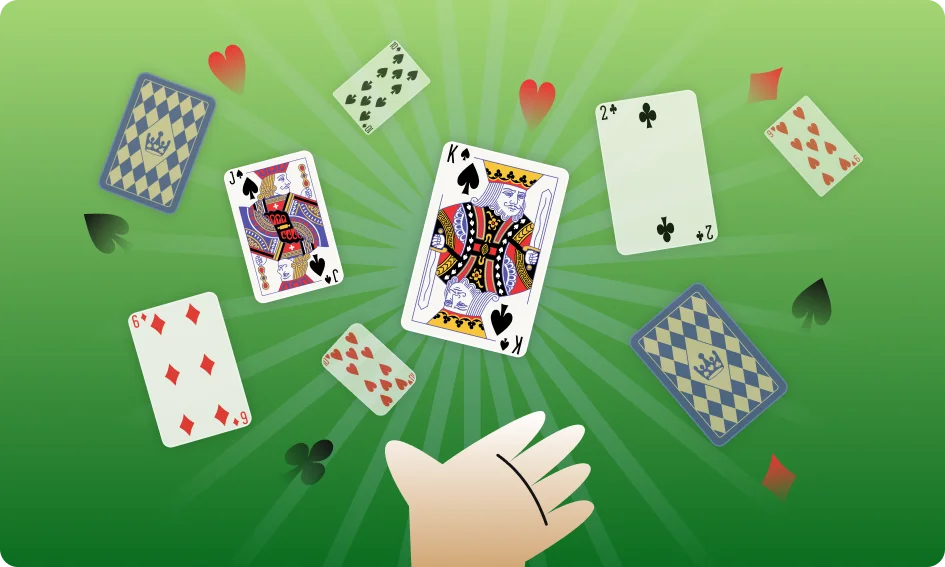Anyone who takes up Solitaire for the first time usually plays Klondike. Many think that it’s the only way to play Solitaire. If they’re like me, then they end up spending hours on Klondike before realizing that Solitaire contains a universe of different variants. They might then try out other mainstream variants like Spider and FreeCell. At this point, they are often left craving for more.
If this sounds like you, then you’ve come to the right place. In this article, I’ll be discussing Solitaire games that are so obscure you’ve probably never encountered them. I had no idea what they were when I heard of them for the first time.
Clock Solitaire
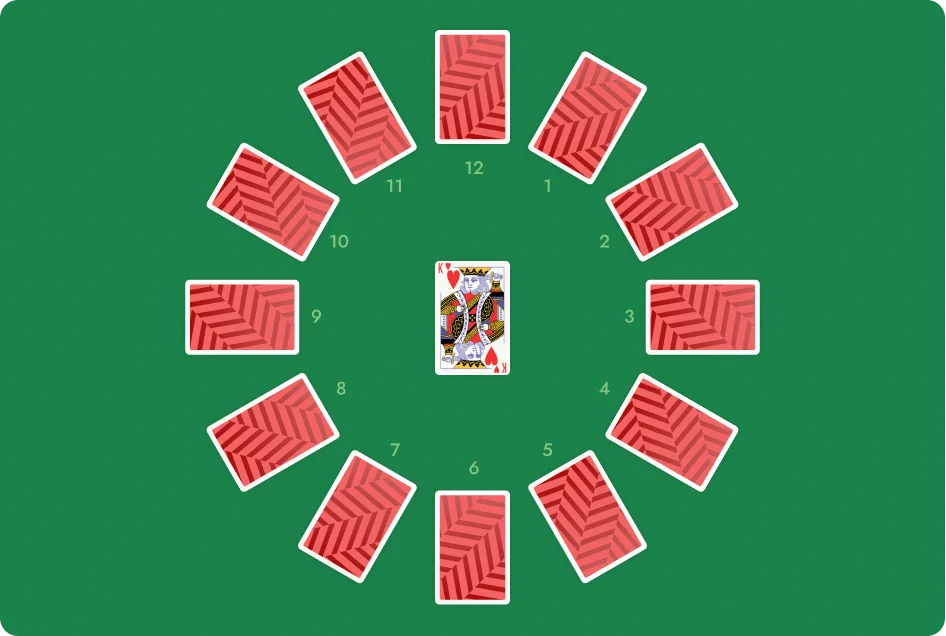
Almost all Solitaire games you’re acquainted with have some degree of skill involved. This influences which of many possible outcomes you’ll get in the game. But, what if I told you that there is a Solitaire game based completely on luck? The outcome is pre-determined, and you just have to do a little work to uncover it. This is Clock Solitaire.
Objective
The objective in Clock Solitaire is to complete all 12 non-King piles before completing the King pile. If you lose the game, then the number of face-down cards represents your score. The lower the score, the better.
Setup
Follow these steps to start a game of Clock Solitaire:
- Take a deck of 52 cards and shuffle it.
- Deal the deck into 13 piles of four cards each, all face-down.
- Arrange 12 out of the 13 piles in a circular fashion, representing a clock.
- Place the last pile in the middle, and you’re ready!
How to Play
As mentioned, Clock Solitaire is a pre-determined game. You play it linearly as follows:
- Your first move is to turn up the center pile’s topmost card. You then move that card to its corresponding pile.
- Next, you play the top card from the pile that you moved the first card to. So, your second move involves turning over the topmost card from the pile where the original card went.
- Every flipped-up card is placed on its corresponding pile face-up.
- This is how you map the cards into piles:
- Ace cards go in the pile corresponding to the 1st hour.
- Deuce cards go in the pile corresponding to the 2nd hour.
- Three cards go in the pile corresponding to the 3rd hour.
- Four cards go in the pile corresponding to the 4th hour.
- Five cards go in the pile corresponding to the 5th hour.
- Six cards go in the pile corresponding to the 6th hour.
- Seven cards go in the pile corresponding to the 7th hour.
- Eight cards go in the pile corresponding to the 8th hour.
- Nine cards go in the pile corresponding to the 9th hour.
- Ten cards go in the pile corresponding to the 10th hour.
- Jack cards go in the pile corresponding to the 11th hour.
- Queen cards go in the pile corresponding to the 12th hour.
- King cards go in the pile in the middle.
Wasp Solitaire
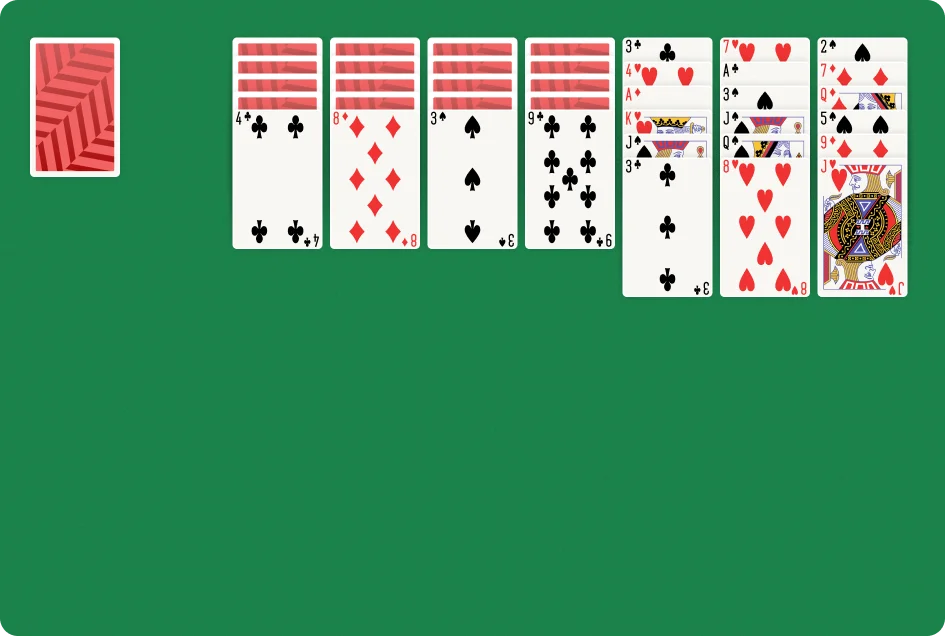
Clock Solitaire is about having lots of luck. Wasp Solitaire is the opposite. This variant is quite difficult and requires lots of skill. My first time playing Wasp was challenging. Some of the rules are quite unforgiving. But, I experienced great joy after winning my first game.
Objective
In Wasp Solitaire, the aim is to build four foundation piles of each suit (Spades, Clubs, Hearts, and Diamonds) in ascending order. Each foundation pile goes from Ace, Deuce, Three, and so on, up to King.
Setup
Follow these steps to set up a game of Wasp Solitaire:
- Take a deck of 52 cards and shuffle it up.
- Deal out the tableau by setting aside seven piles of seven cards. The first four piles have the top four cards face-up, while the rest are face-down. However, the last three piles are face-up. The tableau should consist of 49 of the 52 cards.
- Set aside the remaining three cards as the stock.
- Leave some room for the four foundation piles, and you’re set!
How to Play
Wasp Solitaire has some tricky rules, so read carefully:
- You can move a face-up card from one pile to another as long as it is both the same suit as the card you place it on and one rank lower.
- You can move a group of cards from one pile to another as long as the first card in the group is the same suit as the card you are placing it on and one rank lower. Of course, the rest of the cards in the group must be in sequence (just like in Klondike).
- If a face-down card happens to be at the top of a pile, then you flip it over.
- If there is an empty pile in the tableau, then you can place any card or group of cards there.
- You can’t move individual cards to the foundation piles. Instead, you must complete the full sequence of a suit (from Ace to King). You can then move it to the foundation pile. Sounds tricky, doesn’t it?
- You can only draw from the stock once! Recall that the stock contains three cards. Drawing from the stock means taking all three cards and distributing them across the first three piles in the tableau. Remember that this is a one-time move, so use it timely and wisely.
Aces Up Solitaire
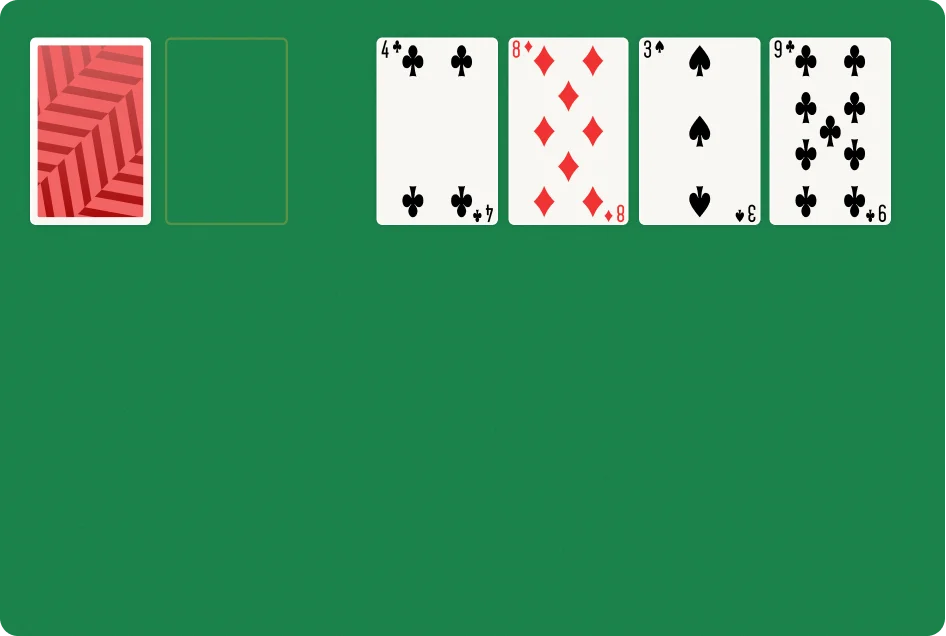
Now we’re delving into some uncharted territory. Clock Solitaire is quite different from Klondike. If you liked Clock, then you’ll love the gimmicky nature of Aces Up Solitaire (also known as Idiot’s Delight). This is a relatively fast-paced game. It typically ends in less than five minutes. So, it’s perfect if you’re pressed for time and looking for some quick fun.
Objective
The objective in Aces Up Solitaire is to get four Aces – one of each suit – lined up in the tableau. There are no foundation piles. So, the game primarily takes place with the stock and a tableau consisting of four empty spaces. You lose if you end up in a situation where the stock has been exhausted, you can’t make any other moves, and the tableau doesn’t solely consist of four Aces.
Setup
Follow these straightforward steps to begin a game of Aces Up Solitaire:
- Take a deck of 52 cards and shuffle it well.
- Deal the top four cards in the deck into each of the four empty spaces on the Tableau.
- Set aside the remaining 48 cards as the stock, and you’re ready to roll!
How to Play
Aces Up Solitaire is mostly based on luck. But, there is some skill involved, which can maximize your chances of winning. So, keep reading to learn how to play:
- If two or more cards from the same suit in the tableau are in their respective piles’ top-most position, then you can keep the highest-ranking card and remove the rest. This can be done at any point in the game.
- For example, if you start the game with an Ace of Spades, King of Spades, Seven of Hearts, and Jack of Diamonds, then you can remove the King of Spades. This is because a card of the same suit, but with a higher rank, is face-up and top-most in the tableau (i.e. the Ace of Spades).
- In this game, Aces have the highest rank (above King).
- You can draw from the stock at any point. Doing so means drawing the top four cards from the stock and distributing them face-up across each of the four tableau piles.
- You can move any of the topmost cards in any pile to an empty pile.
Alternations Solitaire
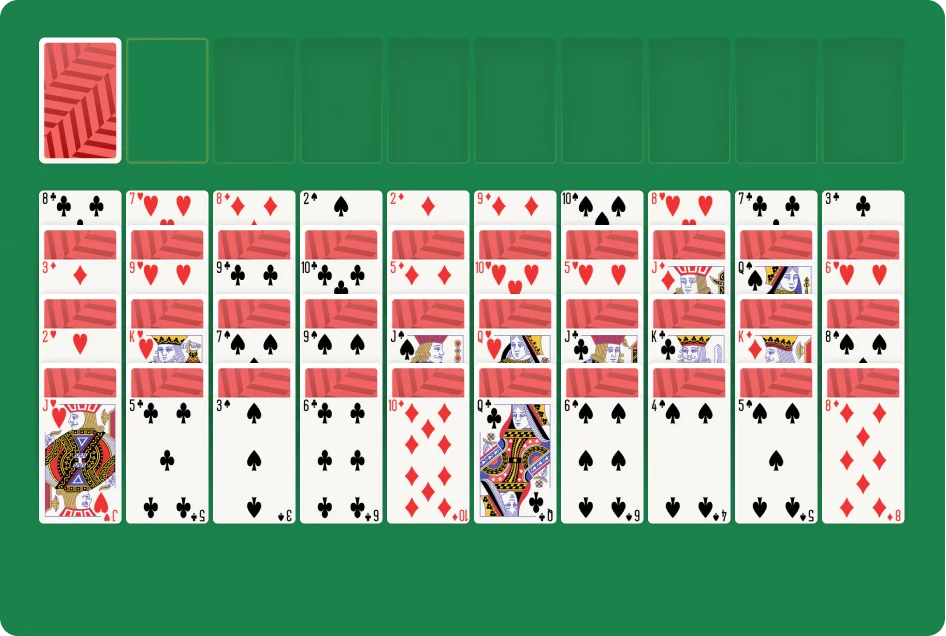
If you want something closer to home – something that’s not as difficult as Wasp or as luck-reliant as Clock Solitaire – then you might enjoy Alternations Solitaire. Aside from the layout and stock usage, Alternations doesn’t have too many gimmicks. It also resembles Double Klondike. So, let’s learn all about it.
Objective
The objective in Alternations Solitaire is to build eight foundation piles of each suit (Spades, Clubs, Hearts, and Diamonds) in ascending order. Each foundation pile should go from Ace, Deuce, Three, and so on, up to King.
Setup
Follow these steps to set up a game of Alternations Solitaire:
- Take two decks of 52 cards and merge them into one big deck.
- Thoroughly shuffle this 104-card deck. The better the shuffle, the better the experience.
- Lay out the tableau by dealing seven piles of seven cards, but only turn over alternate cards. This means that four cards will be face-up and three face-down in each pile. If the top-most and bottom-most card in each pile is face-up, then you’ve set up the tableau correctly.
- Leave some space for the eight foundation piles and set aside the remaining 55 cards face-down. This will make up your stock. Now, you’re good to go!
How to Play
Alternation Solitaire resembles Double Klondike. It should, therefore, be relatively easy to follow these instructions:
- You can move a face-up card from one pile to another as long as it is the opposite color to the card you are placing it on and one rank lower. Spades and Clubs (black Suits) both count as opposites to Hearts and Diamonds (red Suits).
- You can move a group of cards from one pile to another as long as the first card in the group is the opposite color to the card you are placing it on and one rank lower.
- If a face-down card is at the top of a pile, then you can turn it over.
- If there is an empty pile in the tableau, then you can place any card or group of cards there.
- The stock functions similarly to One-Turn Solitaire (e.g. Klondike), where you draw individual cards and put them in the waste pile for usage. The twist is that you can only cycle through the stock once. If you have a habit of relying on the stock when there are strong moves available on the tableau, then it’s time to break that habit.
Josephine Solitaire
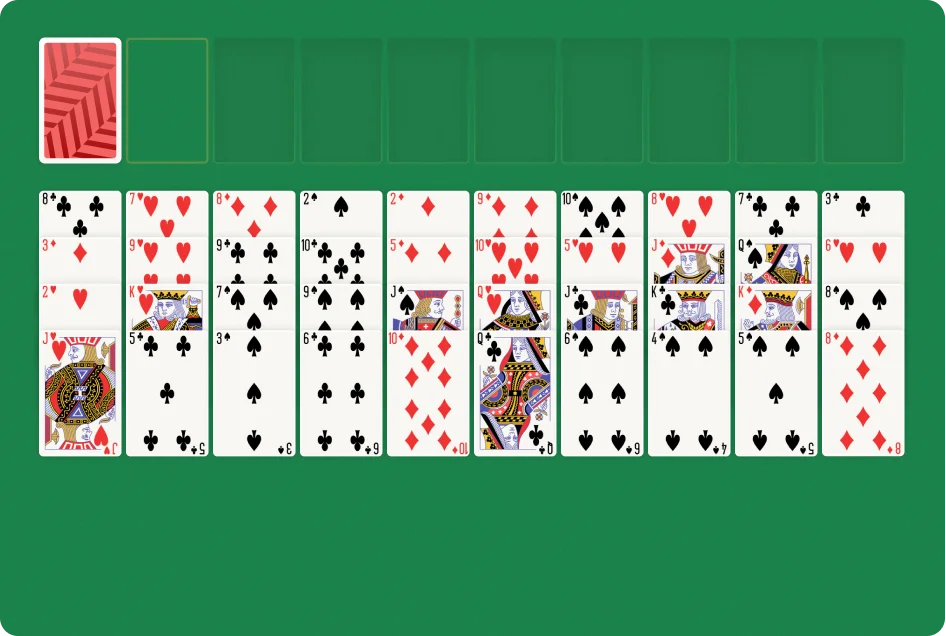
When you hear the word Josephine, you might think of a woman’s name (such as Josephine, Napoleon Bonapart’s wife). But, it’s also the name of an intriguing Solitaire variant. If you’re relatively new to Solitaire and have played some Klondike, then you can try out Josephine Solitaire as your first double-deck variant.
Objective
The objective in Josephine Solitaire is to build eight foundation piles of each suit (Spades, Clubs, Hearts, and Diamonds) in ascending order. Each foundation pile must go from Ace, Deuce, Three, and so on, up to King.
Setup
Follow these steps to begin a game of Josephine Solitaire:
- Take two decks of 52 cards, merge them, and shuffle well.
- To set up the tableau, simply deal out ten piles of cards, each containing four face-up cards. This means that the tableau contains 40 out of the 104 cards.
- Set aside the remaining cards into a deck, face-down. This will serve as the stock. This is a big stock – 64 cards in total. Now, you’re ready!
How to Play
Josephine Solitaire’s rules are relatively easy to learn. Here they are:
- You can move a face-up card from one pile to another as long as it is the same suit as the card you are placing it on and one rank lower.
- You can move a group of cards from one pile to another as long as the first card in the group is the same suit as the card you are placing it on and one rank lower. Of course, the rest of the cards in the group must be in sequence (just like Klondike).
- If a face-down card is at the top of a pile, then you can flip it up. This typically happens when you move a card or group of cards across the tableau or into the foundation piles.
- If there is an empty pile in the tableau, then you can only move a King or a group of cards starting with a King into it.
Crescent Solitaire
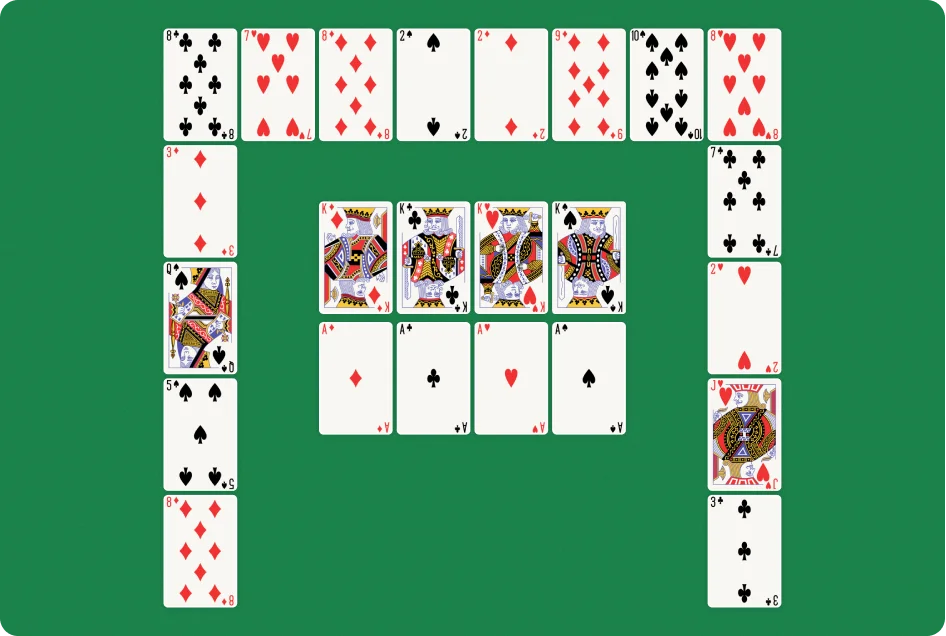
You might like Clock Solitaire’s quirky layout but not its luck-based nature. If so, then let me introduce you to Crescent Solitaire. This variant is less known among two-deck Solitaire games. Indeed, veterans consider it to be one of the harder variants to contend with. Nonetheless, if you’ve played Spider (even with just one suit), then I encourage you to try Crescent Solitaire.
Objective
The objective in Crescent Solitaire is to build eight foundation piles of each suit (Spades, Clubs, Hearts, and Diamonds). Four are built in ascending order and four in descending order. Each ascending foundation pile will go from Ace, Deuce, Three, and so on, up to King. Each descending foundation pile will go from King, Queen, Jack, and so on, down to Ace.
Setup
Follow these steps to set up a game of Crescent Solitaire:
- Take two decks of 52 cards and combine them into a larger deck of 104 cards. Shuffle this deck thoroughly.
- Before dealing out the tableau, remove one Ace and one King from each suit in the deck. This is because the first card of each foundation pile is already present in Crescent Solitaire. You only have to worry about building on top of them.
- Set up the tableau by putting down sixteen piles of cards, each containing six cards with the topmost card face-up. Then, align the piles in a semi-circular fashion (sort of like a square, but with three sides).
- Set up the foundation piles within the confines of the crescent-shaped tableau with the previously removed Ace and King cards.
- There is no stock in Crescent Solitaire. You deal all cards in the deck into the tableau and foundation piles beforehand. You’re all set to begin!
How to Play
Crescent Solitaire has an interesting set of rules:
- You can move a face-up card from one pile to another as long as it is the same suit as the card you are placing it on and either one rank lower or higher.
- You can move a group of cards from one pile to another as long as the first card in the group is the same suit as the card you are placing it on and either one rank lower or higher. The rest of the cards in the group can be in any sequence.
- If a face-down card is at the top of a pile, then you can flip it up.
- If a pile becomes vacant, then you can place any card or group of cards there.
- If you run out of moves to make, then you can make a special “shuffle” move. This involves bringing the bottom-most card from each pile to the top (instead of shuffling each pile in the tableau). The number of shuffles you are afforded depends on the difficulty level you are playing at. Typically, nine shuffles are allowed in easy mode, six in medium, and three in hard.
Russian Solitaire
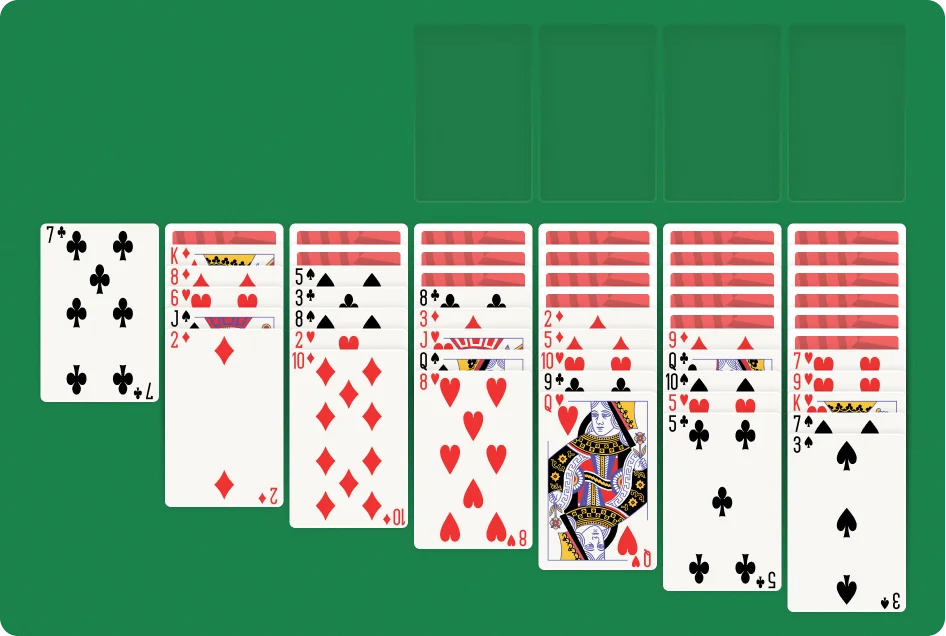
Russian Solitaire is a less-known Solitaire variant. This is partially because it is a variation of the more famous Yukon Solitaire. While these variants share the same objective and setup, there are rule differences. These make Russian Solitaire slightly more tricky to contend with. As such, I recommend trying out Yukon Solitaire before Russian Solitaire.
Objective
The objective in Russian Solitaire is to build four foundation piles of each suit (Spades, Clubs, Hearts, and Diamonds) in ascending order. Each foundation pile will go from Ace, Deuce, Three, and so on, up to King.
Setup
Follow these steps to prepare a game of Russian Solitaire:
- Take a deck of 52 cards and shuffle it up.
- The tableau consists of seven piles. These take up the entire deck of 52 cards. You then deal out as follows:
- On the 1st pile, place one card face-up; no other card will go on this pile.
- On the 2nd pile, place one card face-down and stack five cards face-up thereon.
- On the 3rd pile, stack two cards face-down and five cards face-up thereon.
- On the 4th pile, stack three cards face-down and five cards face-up thereon.
- On the 5th pile, stack four cards face-down and five cards face-up thereon.
- On the 6th pile, stack five cards face-down and five cards face-up thereon.
- On the 7th pile, stack six cards face-down and five cards face-up thereon.
- There is no stock in Russian Solitaire because all the cards in the deck go into the tableau. You’re ready to begin!
How to Play
If you’ve played Yukon Solitaire, then you’ll find it relatively easy to understand Russian Solitaire’s rules. If you haven’t, then read carefully:
- You can move a face-up card from one pile to another as long as it is the same suit as the card you are placing it on and one rank lower.
- You can move a group of cards from one pile to another as long as the first card in the group is the same suit as the card you are placing it on and one rank lower The rest of the cards in the group do not matter.
- If a face-down card is at the top of a pile, then you can turn it over.
- If there is an empty pile in the tableau, then you can only move a King or a group of cards starting with a King into that space.
| Solitaire Game | Description |
| Clock Solitaire | A purely luck-based variant. Perfect for players looking to divorce themselves from Solitaire’s strategic aspects. |
| Wasp Solitaire | The most difficult variant on this list. Some rules are especially unforgiving: You can only move complete sequences (from Ace to King) onto the foundation piles instead of individual cards. |
| Aces Up Solitaire | This variant is perfect for players looking for a quick game but who don’t want something as luck-based as Clock Solitaire. Try it out; you’ll be done in less than five minutes. |
| Alternations Solitaire | If you want to spice things up with a rather twisted tableau layout, then try this one out. As the name implies, each pile in the tableau is dealt out with alternating face-up and face-down cards. |
| Josephine Solitaire | Two-deck Solitaire variants often have a reputation for being difficult (due to games like Spider). But, Josephine is actually quite easy. In fact, I’d recommend it as the first two-deck Solitaire game you try out. |
| Crescent Solitaire | This game is perfect for those who want both gimmicks and skill-demanding gameplay. You can probably figure out one of the game’s gimmicks (it’s mentioned in the name). |
| Russian Solitaire | Not many Solitaire games have variants of themselves. Russian Solitaire is likely the first such game you’ve heard of. It’s a less-known variation of Yukon Solitaire, both of which I recommend you try out. |
Conclusion
There you have it! These are seven relatively unknown Solitaire games. You should definitely try them out if you haven’t already. Part of Solitaire’s beauty is that it has so many variants. This means that it never gets boring, and it’s why I’ve been consistently playing this wonderful game for many years.


